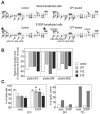Cancer-associated S100P protein binds and inactivates p53, permits therapy-induced senescence and supports chemoresistance
- PMID: 26967060
- PMCID: PMC5008377
- DOI: 10.18632/oncotarget.7999
Cancer-associated S100P protein binds and inactivates p53, permits therapy-induced senescence and supports chemoresistance
Abstract
S100P belongs to the S100 family of calcium-binding proteins regulating diverse cellular processes. Certain S100 family members (S100A4 and S100B) are associated with cancer and used as biomarkers of metastatic phenotype. Also S100P is abnormally expressed in tumors and implicated in migration-invasion, survival, and response to therapy. Here we show that S100P binds the tumor suppressor protein p53 as well as its negative regulator HDM2, and that this interaction perturbs the p53-HDM2 binding and increases the p53 level. Paradoxically, the S100P-induced p53 is unable to activate its transcriptional targets hdm2, p21WAF, and bax following the DNA damage. This appears to be related to reduced phosphorylation of serine residues in both N-terminal and C-terminal regions of the p53 molecule. Furthermore, the S100P expression results in lower levels of pro-apoptotic proteins, in reduced cell death response to cytotoxic treatments, followed by stimulation of therapy-induced senescence and increased clonogenic survival. Conversely, the S100P silencing suppresses the ability of cancer cells to survive the DNA damage and form colonies. Thus, we propose that the oncogenic role of S100P involves binding and inactivation of p53, which leads to aberrant DNA damage responses linked with senescence and escape to proliferation. Thereby, the S100P protein may contribute to the outgrowth of aggressive tumor cells resistant to cytotoxic therapy and promote cancer progression.
Keywords: HDM2; S100P calcium-binding protein; cell death; p53 tumor suppressor; therapy-induced senescence.
Conflict of interest statement
The authors declare no conflict of interest.
Figures







Similar articles
-
S100P Interacts with p53 while Pentamidine Inhibits This Interaction.Biomolecules. 2021 Apr 24;11(5):634. doi: 10.3390/biom11050634. Biomolecules. 2021. PMID: 33923162 Free PMC article.
-
UBTD1 induces cellular senescence through an UBTD1-Mdm2/p53 positive feedback loop.J Pathol. 2015 Mar;235(4):656-67. doi: 10.1002/path.4478. Epub 2015 Jan 7. J Pathol. 2015. PMID: 25382750
-
Transcriptional regulation and functional implication of S100P in cancer.Amino Acids. 2011 Oct;41(4):885-92. doi: 10.1007/s00726-010-0495-5. Epub 2010 Feb 14. Amino Acids. 2011. PMID: 20155429 Review.
-
Pre-apoptotic response to therapeutic DNA damage involves protein modulation of Mcl-1, Hdm2 and Flt3 in acute myeloid leukemia cells.Mol Cancer. 2007 May 11;6:33. doi: 10.1186/1476-4598-6-33. Mol Cancer. 2007. PMID: 17498302 Free PMC article.
-
S100P, a peculiar member of S100 family of calcium-binding proteins implicated in cancer.Acta Virol. 2013;57(2):238-46. doi: 10.4149/av_2013_02_238. Acta Virol. 2013. PMID: 23600880 Review.
Cited by
-
Attenuation of cancer-initiating cells stemness properties by abrogating S100A4 calcium binding ability in head and neck cancers.Oncotarget. 2016 Nov 29;7(48):78946-78957. doi: 10.18632/oncotarget.12935. Oncotarget. 2016. PMID: 27793047 Free PMC article.
-
S100P as a potential biomarker for immunosuppressive microenvironment in pancreatic cancer: a bioinformatics analysis and in vitro study.BMC Cancer. 2023 Oct 18;23(1):997. doi: 10.1186/s12885-023-11490-1. BMC Cancer. 2023. PMID: 37853345 Free PMC article.
-
LncRNA NORAD is repressed by the YAP pathway and suppresses lung and breast cancer metastasis by sequestering S100P.Oncogene. 2019 Jul;38(28):5612-5626. doi: 10.1038/s41388-019-0812-8. Epub 2019 Apr 9. Oncogene. 2019. PMID: 30967631
-
Distinct prognostic values of S100 mRNA expression in breast cancer.Sci Rep. 2017 Jan 4;7:39786. doi: 10.1038/srep39786. Sci Rep. 2017. PMID: 28051137 Free PMC article.
-
CAIX-Mediated Control of LIN28/let-7 Axis Contributes to Metabolic Adaptation of Breast Cancer Cells to Hypoxia.Int J Mol Sci. 2020 Jun 16;21(12):4299. doi: 10.3390/ijms21124299. Int J Mol Sci. 2020. PMID: 32560271 Free PMC article.
References
-
- Bertram J, Palfner K, Hiddemann W, Kneba M. Elevated expression of S100P, CAPL and MAGE 3 in doxorubicin-resistant cell lines: comparison of mRNA differential display reverse transcription-polymerase chain reaction and subtractive suppressive hybridization for the analysis of differential gene expression. Anticancer Drugs. 1998;9:311–17. - PubMed
-
- Arumugam T, Simeone DM, Van Golen K, Logsdon CD. S100P promotes pancreatic cancer growth, survival, and invasion. Clin Cancer Res. 2005;11:5356–64. - PubMed
MeSH terms
Substances
LinkOut - more resources
Full Text Sources
Other Literature Sources
Molecular Biology Databases
Research Materials
Miscellaneous

